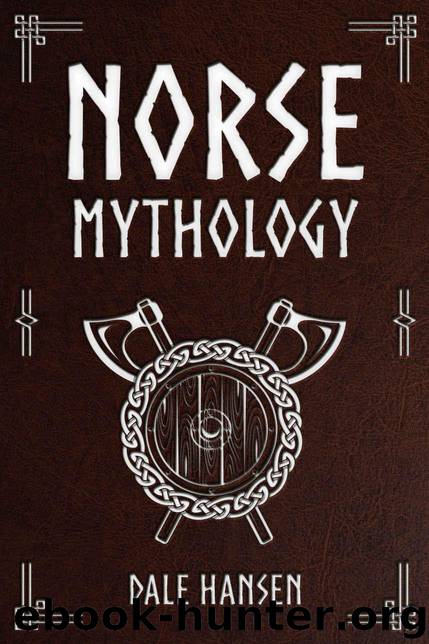Norse Mythology: Tales of Norse Gods, Heroes, Beliefs, Rituals & the Viking Legacy. by Hansen Dale

Author:Hansen, Dale [Hansen, Dale]
Language: eng
Format: azw
Published: 2017-11-27T16:00:00+00:00
Chapter Seven: Other Supernatural Beings
In addition to human beings with magical powers, other legendary creatures populated the Scandinavian mythos. Some of these creatures included dwarves, elves, wights, giants, the Norns and the landscape features like mountains and wells.
Dwarves
There are a couple origin stories for dwarves, one being in the Poetic Edda and saying tha the dwarves were made from the blood and bones of the giant,Ymir. In Snorri Sturluson’s Prose Edda, the dwarves were more like parasitic pests that infested the giant Ymir’s body and grew when he was killed.
The dwarves had various roles in the few stories where we encounter them in the Poetic Edda and Prose Edda. The four dwarves, Nordri, Sudri, Austri, and Vestri, or “North,” “South,” “East,” and “West” in Old Norse, were said to hold up the vaulted ceiling of the sky. In other stories, they created the mead of poetry that Odin stole and drank, and they forge Mjollnir, Thor’s hammer as well.
Elves
Elves were first discovered by modern historians in the Prose Edda recorded by Snorri Sturluson. It seems that Icelandic sources are rich with references to Elves, though the rest of Viking culture in Scandinavia only rarely, if ever, mentions elves, or alfar. The reference in Snorri Sturluson’s work that most historians cited as evidence for the Vikings’ belief in elves, however, has been un-substantiated.
Instead, we look to the Elder Edda for information about elves. Elves were considered nearly-human in many ways, and might even have been the dead spirits of humans in some reckonings. Volundr was a character identified as an elf in the work, Volundarkvida. Elves were often associated alliteratively with the Ases, and it seemed Freyr was somewhat associated with the elven beings, having taken over Alfheimr, literally “elf-world.”
Elves were considered super-human and supernatural in a few senses, mostly in the sense that they were more beautiful and wiser than their human counterparts.
Wights
Wights were technically any sentient, living creature, thus including the elves, the dwarves, the giants, the gods, and human beings. However, in Norse mythology, when a person referenced a vettr, or wight in Old Norse, they were referring to a specific supernatural being that was tied to a certain aspect of nature, such as the land wights.
Land wights, or landvaettir, guarded specific areas of land in Viking mythology. Because of this, Vikings would take the carved dragon heads off the front of their long-ships before coming into port in order to not frighten and provoke an attack by the land wights.
The four land wights of Iceland are still found on its coat-of-arms. A troll-bull, a troll-eagle, a dragon, and a handsome giant were considered to be the four wights that protected the island of Iceland from attack and other disasters.
Giants
Giants represented the infertile regions of the world: the rocky places and the northern icy areas, and generally any hostile region that the Vikings could imagine. Giants lived in the circle of the Nine Worlds called Jottunheim, or alternatively, they lived in Utgard, depending on the conception of the world under which the specific Viking was operating.
Download
This site does not store any files on its server. We only index and link to content provided by other sites. Please contact the content providers to delete copyright contents if any and email us, we'll remove relevant links or contents immediately.
Aircraft Design of WWII: A Sketchbook by Lockheed Aircraft Corporation(31767)
The Great Music City by Andrea Baker(21193)
Call Me by Your Name by André Aciman(18952)
The Art of Boudoir Photography: How to Create Stunning Photographs of Women by Christa Meola(17834)
Shoot Sexy by Ryan Armbrust(17133)
Plagued by Fire by Paul Hendrickson(16630)
The Secret History by Donna Tartt(16606)
Portrait Mastery in Black & White: Learn the Signature Style of a Legendary Photographer by Tim Kelly(16478)
Adobe Camera Raw For Digital Photographers Only by Rob Sheppard(16380)
Photographically Speaking: A Deeper Look at Creating Stronger Images (Eva Spring's Library) by David duChemin(16151)
Bombshells: Glamour Girls of a Lifetime by Sullivan Steve(13100)
Pimp by Iceberg Slim(12922)
Ready Player One by Cline Ernest(12828)
The Goal (Off-Campus #4) by Elle Kennedy(12423)
Art Nude Photography Explained: How to Photograph and Understand Great Art Nude Images by Simon Walden(12339)
Kathy Andrews Collection by Kathy Andrews(10506)
Thirteen Reasons Why by Jay Asher(7780)
Wonder by R.J. Palacio(7723)
Goodbye, Things by Fumio Sasaki(7719)
